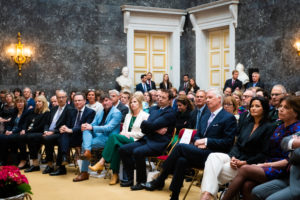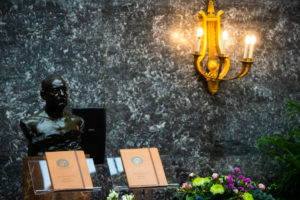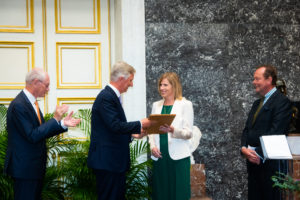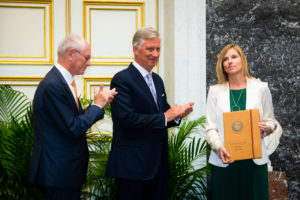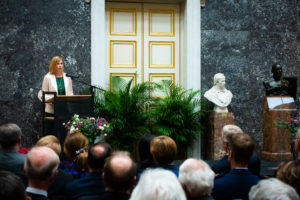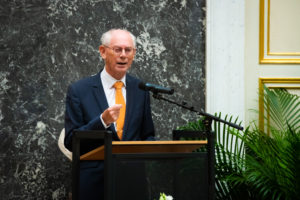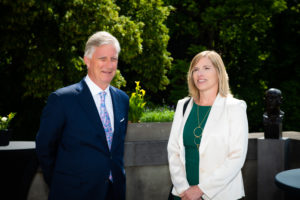2022 Report Veerle ROTS
Ceremony of the Francqui Prize by his Majesty The King on June 1, 2022
(by invitation only )

Carrier – Works – Report of the Jury
Her career
Veerle Rots was born in Leuven in 1974. From an early age, her father fostered her interest in science and at home she came across a book about prehistory and human evolution. That is how she became fascinated by this subject at the end of primary school. It was a passion that grew during her studies in Latin and Sciences at secondary school (Heilig Hart Institute, Heverlee). And so, with full conviction, she chose to study archaeology at the KU Leuven (1992-1996). The lessons, the seminars and especially the fieldwork at Sodmein Cave in the eastern desert of Egypt to which Professor Pierre Vermeersch invited her to participate had an indelible influence on her further course. She was introduced to use-wear analysis, a method which through microscopic examination reveals what stone tools were used for. This enables far-reaching interpretations about, for instance, the organisation and function of prehistoric sites. Other excavations followed, in Poland and Turkey among others, and her interest in scientific research was definitely aroused.
Thanks to a grant from the KU Leuven Special Research Fund, she was able to start her doctoral research on the hafting of stone tools at the end of 1997, under the supervision of Professor Pierre Vermeersch. The question whether hafting could also lead to the formation of microscopic wear traces had not yet been systematically investigated. Several researchers even seriously doubted its feasibility. Through pioneering experimental research, however, Veerle Rots was able to demonstrate that hafting wear traces indeed form. She also set off to establish a methodology that would make their identification and interpretation possible. In her replication of the prehistoric stone tools, she was grateful to benefit from the expertise of the stone knappers at CETREP (Centre d’Étude des Techniques et de Recherche Expérimentale en Préhistoire / Centre for the Study of Techniques and Experimental Research in Prehistory), affiliated with the association Les Chercheurs de la Wallonie.
After the ground-breaking results of her doctoral thesis, which she defended in 2002, she obtained several successive postdoctoral fellowships (2002-2011, Bijzonder Onderzoeksfonds and FWO-Vlaanderen). These fellowships gave her the opportunity, under the supervision of Professor Philip Van Peer, to focus her research on the application of the methodology she had developed during her PhD. She examined archaeological material from the Leuven excavations in Egypt (under supervision of Prof. P. Vermeersch and Prof. P. Van Peer) and on the island of Sai in Sudan (under supervision of Prof. P. Van Peer). The research in Sudan, among others, enabled her to identify the oldest traces of hafting in Africa, dating back to about 200,000 years. At this stage of her career, she gradually integrated more European sites into her research with the aim of starting a comparative study of Neanderthals and early modern humans by means of functional analysis. Pursuing this line of research, she succeeded in finding the oldest known traces of hafting at the site of Biache-St-Vaast in France, which dates to around 250,000 years ago. In 2013, she published the results in the Journal of Archaeological Science.
Obtaining a permanent position (Chercheur Qualifié du FNRS) in 2011 marked a turning point in her career. She moved her research activities to University of Liège. With the support of the European Research Council, which awarded her a Starting Grant in 2012, she set up TraceoLab, a brand-new research centre which immediately became a model on an international scale. Between 2013 and 2017, she ran the research project entitled « The Evolution of Stone Tool Hafting in the Palaeolithic ». This project allowed her to purchase the necessary equipment and recruit a research team. Several doctoral studies were initiated and a reference collection of stone tools with traces representative of different uses and hafting methods was produced. Residue analysis was also integrated into the functional approach. New research topics were added and, in addition to hafting, the evolution of projectile technology became a central research theme. Remarkable constants were the attention paid to methodological innovation and the frequent collaboration with experts from other fields, including ballistics and chemistry. Strong international collaborations were also established through various archaeological excavation projects. Veerle Rots and her team began to work closely together with for example Professor Nicholas Conard of the University of Tübingen on sites such as Schöningen, Hohle Fels and Vogelherd in Germany and Sibudu Cave in South Africa, many of which have earned a UNESCO World Heritage status. Collaborative research is likewise carried out with Professor Lawrence Barham of the University of Liverpool at sites such as Kalambo Falls and Victoria Falls in Zambia. With Dr Guillaume Porraz (CNRS) she works on Bushman Rock Shelter and Diepkloof Cave in South Africa, and Prés de Laure in France, in the excavation of which she has become increasingly involved over the years.
TraceoLab is rapidly becoming an internationally recognised reference centre for functional research and a meeting place for young researchers, including several holders of prestigious grants (e.g. Marie Curie), from all over the world. Today, the group comprises around fifteen researchers, including an expert in experimental stone working. Veerle Rots’s creativity and her ability to integrate experimental archaeology with analytical protocols from the ‘hard’ sciences and questions from the humanities have proved to be a real magnet for a new generation of researchers. They find at TraceoLab the ideal context to transcend the traditional academic divisions and to put all the possibilities of science and technology to the service of research.
In 2019, Veerle Rots was promoted to Maître de Recherches of the FNRS.
Her commitment to the promotion and evaluation of scientific research has a lengthy history and has developed both within the University of Liège and internationally. From 2012 to 2018, Veerle Rots was Vice-President of the international association AWRANA (Association of Wear and Residue Analysts), which she co-founded. She now serves for a second time on the SHS-4 committee of the FNRS. In 2016, she became a member and in 2019 the vice-president of the Human Sciences Research Council at the University of Liege. Since 2019, she is also a member of the University Research Council.
Veerle Rots and her partner Koen Beerten, PhD in Geology, are the proud parents of three sons, Eppo (°2005), Nuno (°2007) and Ramon (°2012).
* * *
Her works
Veerle Rots focuses her research on the Old Stone Age (the Palaeolithic). She wants to understand what distinguishes modern humans from archaic ones and therefore works in both Europe and Africa. The fact that the history of modern humans is much longer in Africa than in Europe makes it possible to study Neanderthal sites and early modern human sites of roughly the same age and to compare the material culture and ways of life of these two species of humans. Veerle Rots and her team study the remains of prehistoric technology at sites dated to between about 300,000 and 10,000 years ago with the aim of understanding the human behaviour behind the material remains. Through the examination of stone tools, she tries to access other aspects of technology and past lifeways of which direct material evidence has not survived. She is also looking for clues that would allow us to understand how modern humans spread around the world, in particular towards Europe, about 45,000 years ago during a period marked by the decline and subsequent disappearance of Neanderthals. In Africa, she has been active in Egypt, Sudan and Ethiopia, and in recent years has worked mainly in South Africa, Zambia and Morocco. She has also worked on sites in Belgium, France, Germany and Italy.
Veerle Rots looks for nearly invisible traces of prehistoric human life and has developed innovative methods that shed new light on fundamental questions. She specialises in the functional examination of stone tools and wants to understand the story behind them by examining the traces preserved on the stones. The wear marks, which are often invisible to the naked eye, reveal various aspects of the life of prehistoric communities. For example, they reflect not only technology and subsistence strategies, but also the function of a site, the organisation of activities across the landscape and, more generally, the complexity of human behaviour. The application of innovative functional research to several Palaeolithic sites in Europe and Africa, some of which exceptionally well preserved, has provided essential revisions to our knowledge of the human past. More specifically, Veerle Rots is developing a comprehensive and integrated approach to functional research. Her focus is on traces that are created throughout the use cycle of a tool, from the moment of its production and hafting to the moment when it is discarded after its use and possible resharpening. She has developed a new methodology to determine by microscopic examination whether tools were mounted on handles made of organic materials. Organic material only survives in exceptional circumstances and is therefore extremely rarely encountered at sites dated to the older Palaeolithic. Only unique sites such as Schöningen, dated to around 300,000 years ago, provide insights into organic technology. A series of wooden spears were discovered there in the past. A throwing stick that Veerle Rots identified was recently added to this exceptional discovery of an early weapon set. In 2020, she published her findings in the journal Nature Ecology and Evolution. For most sites, however, it is the stone tools that provide a window into organic technology. Veerle Rots has been able to show that the concept of hafting is an early prehistoric invention that can safely be called revolutionary. The invention not only lies at the basis of all our current tools, but also tells us about the cognitive capacities of prehistoric humans, including their ability to plan ahead and to anticipate future activities. By applying the new methodology to various prehistoric sites in Europe and Africa, Veerle Rots has managed to demonstrate that humans were capable of hafting tools by latest 250,000 years ago.
In addition, Veerle Rots has provided new impetus for research into projectile technology. She has improved the methods for identifying projectiles and has been able to determine, for instance, that hafted stone projectiles already occurred around 250,000 years ago in Europe, at least 100,000 years ago in North Africa and 77,000 years ago in South Africa. Her ongoing research may push these dates even further back in time. Together with her team, she has also built a new solid methodological framework combining use-wear analysis, study of fracture mechanics, ballistic analysis and systematic experimentation. This has radically changed the way we view hunting, a central activity in the life of prehistoric humans that has important implications for our understanding of social organisation. TraceoLab’s research has also provided crucial building blocks for determining the propulsion method of projectiles. By doing so, the team has added resolution to the current view of the evolution of projectile technology through time. The new methods make it possible to find out when long-distance weapons such as the spear-thrower and the bow were adopted and whether these technologies were unique to modern humans or also known to Neanderthals.
With TraceoLab, Veerle Rots quickly created an internationally recognised research centre for functional and experimental research in Liège. The radical opting for innovative present-day technology enables the study of technology from the past. The examples are numerous: the production and hafting methods and modes of use of stone tools can be determined through analysis with various microscopes; the ballistics of projectiles can be examined with, among others, a high-speed camera; the fracture mechanics of stones are explored with a universal testing machine; past natural processes, such as glacial cycles, can be reproduced with the aid of, among others, a climate chamber. The unique and particularly extensive and rich experimental reference collection of microscopic traces (TRAIL) is not only an international benchmark but also sets new standards for this type of research.
The scope of Veerle Rots’s and her team’s research is broad. Her past and present activities increase our understanding of how inorganic and organic parts of prehistoric technology interacted, how past dynamics worked, and how technological innovations mark our history. Understanding how people used technology to shape their environment and their daily lives and how they organised their activities across a landscape is a challenge that, when met, allows us to unravel the origins of humanity.
* * *
Report of the Jury (May 7, 2021)
The 2022 Francqui Prize is awarded to Veerle Rots for her fundamental research into the use of Palaeolithic stone tools by humans and their ancestors, opening up new perspectives on the evolution of society through material remains spanning several million years. Her observations address profound research questions on the way early humans lived and worked.
Veerle Rots completed her PhD at the University of Leuven, where she developed a framework to identify the hafting of stone tools. Hafting refers to the attachment of a stone tool to a handle made from an organic material such as wood. Her discoveries are based on examining traces of ‘wear and tear’ (use-wear, that is, scratches and residues) preserved on the tool using high-power microscopes and biochemistry. Application of this method to a series of stone tool assemblages enabled insights into the antiquity and complexity of hafting behaviour in Middle to Late Pleistocene Africa and Europe. The value of this research was recognised in the award of a European Research Council Starting Grant, and culminated in the foundation of the TraceoLab at the University of Liège. Under her leadership, this group studies and interprets stone tool function through analysis of use-wear and related experimental and ethnographic work. The lab is known for its unique, open-source database of thousands of specimens and exceptional reference collection.
The work of Veerle Rots and her group generates totally new data on the use of stone tools through the vast Palaeolithic period, for which such tools constitute by far the most widespread form of archaeological evidence. Her multi-stranded approach to the analysis of stone tools is deployed to reconstruct hafting behaviours, the use of glues in hafting and the use of projectiles, revealing the invention of specific ways of throwing projectiles. These methods are being applied to archaeological sites across the globe, and open up a new potential for the comparative analysis of stone tool assemblages. Systematic analysis of ‘wear and tear’ in the new framework has shed light on the surprising antiquity of hafting (back to 200,000 years ago) and related techniques, their contexts of emergence and development over time. This ground-breaking work has the potential to reshape our understanding of skill and technology in human evolution.
Members of the international jury :
Eric Maskin is the Adams University Professor and Professor of Economics and Mathematics at Harvard. He has made contributions to game theory, contract theory, social choice theory, political economy, and other areas of economics. He received his A.B. and Ph.D. from Harvard and was a postdoctoral fellow at Jesus College, Cambridge University. He was a faculty member at MIT from 1977-1984, Harvard from 1985- 2000, and the Institute for Advanced Study from 2000-2011. He rejoined the Harvard faculty in 2012. In 2007, he was awarded the Nobel Memorial Prize in Economics (with L. Hurwicz and R. Myerson) for laying the foundations of mechanism design theory.
Chairman
and
Catherine Barnard, FBA, FLSW, FRSA is Professor of EU law and Employment Law and senior tutor and fellow of Trinity College, Cambridge. She is the author of EU Employment Law (Oxford, OUP, 2012, 5th ed.), The Substantive Law of the EU: The Four Freedoms, (Oxford, OUP, 2019, 6th ed), and (with Peers ed), European Union Law (Oxford, OUP, 2020, 3rd ed). She is a member of the European Commission funded European Labour Law Network (ELLN). She is also a Senior Fellow and deputy director of the UK in a Changing Europe (http://ukandeu.ac.uk/) project (UKCE). This is an authoritative, non-partisan think-tank which does research and provides information about all aspects of Brexit. Part of its remit is to make that information accessible to the general public. So UKCE does a lot of public engagement, especially with the media, civil servants, politicians and the public. She has appeared on the main media channels – BBC, ITV, Sky sand CNN.
Amy Bogaard is Professor of Neolithic and Bronze Age Archaeology at the School of Archaeology, University of Oxford. Her research focuses on the ecology, evolution and social implications of early farming systems in Europe and western Asia, with comparative interests in other parts of the world. Her research integrates archaeological evidence with heuristic models of present-day ‘traditional’ farming systems to investigate topics such as ancient agroecology and wealth inequality.
Jean-Louis Cohen : Trained as an architect and an historian, Jean-Louis Cohen holds the Sheldon H. Solow Chair in the History of Architecture at New York University’s Institute of Fine Arts. He has published more than forty books, including: Building a New New World (2020), Le Corbusier: an Atlas of Modern Landscapes (2013), Architecture in Uniform (2011), Casablanca (2002), and Le Corbusier and the Mystique of the USSR (1992).
Fotini Christia is the Ford International Professor in the Social Sciences at MIT and the Director of the Sociotechnical Systems Research Center (SSRC) at MIT’s Schwarzman College of Computing. She joined the MIT faculty in Political Science in 2008 upon graduating with a PhD in Public Policy from Harvard University. Prof. Christia has done extensive experimental, survey and ethnographic fieldwork on conflict, identity, and development in divided societies in the Muslim world. She is the author of Alliance Formation in Civil War, published by Cambridge University Press in 2012, which received the Luebbert Award for Best Book in Comparative Politics, the Lepgold Prize for Best Book in International Relations and the Distinguished Book Award of the Ethnicity, Nationalism, and Migration Section of the International Studies Association. Her articles have been published or are forthcoming in Science, Nature Human Behavior, the Review of Economic Studies, American Political Science Review, Journal of Development Economics, and Annual Review of Political Science, among other journals.
Donald Katz : After majoring in Cognitive and Linguistic Sciences as an undergraduate at Brown University, Katz studied both clinical psychology and neuroscience at Indiana University. As a postdoctoral researcher at Duke University Medical Center, he discovered his fascination with the neurobiology of taste, which is the focus of his scholarship at Brandeis University; there, he has earned The Jeanette Lerman-Neubauer ’69 and Joseph Neubauer Prize for Excellence in Teaching and Mentoring, the Brandeis Student Union Teaching Award, and The Michael L. Walzer Award for Teaching and Scholarship. He has also received the Ajinomoto prize and the Swartz Mind-Brain award for his science. He is currently a Professor of Psychology and Neuroscience.
Jan Theeuwes is professor of Cognitive Psychology of the Vrije Universiteit, Amsterdam and the director of Institute for Brain and Behavior Amsterdam (iBBA). He conducts basic and applied research involving humans on attention, perception and memory using a variety of techniques including EEG, fMRI, and modeling. He is a member of the Royal Dutch Academy of Science (KNAW). In 2013, he received an European Research Council (ERC) advanced grant of 2.5 million euro on reward processing and in in 2019 a second ERC advanced grant on attention and statistical learning. He was President of ESCoP (European Society for Cognitive Psychology). His work has been highly influential as his papers rank within the top 1% within his research field (web of science).
Martti Koskenniemi is Professor Emeritus of International Law at the University of Helsinki and Visiting Hauser Global Professor of Law at New York University Law School. He was a member of the Finnish diplomatic service in 1978-1994 and of the International Law Commission (UN) in 2002-2006. He is member of the Institut de droit international, Fellow of the British Academy and Member of the American Academy of Arts and Sciences. His most recent book is To the Uttermost parts of the Earth. Legal Imagination and International Power 1300–1870 (Cambridge 2021).
Members
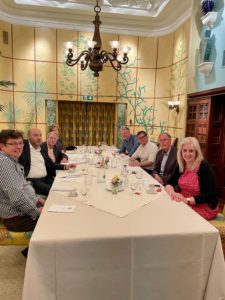
* * *
